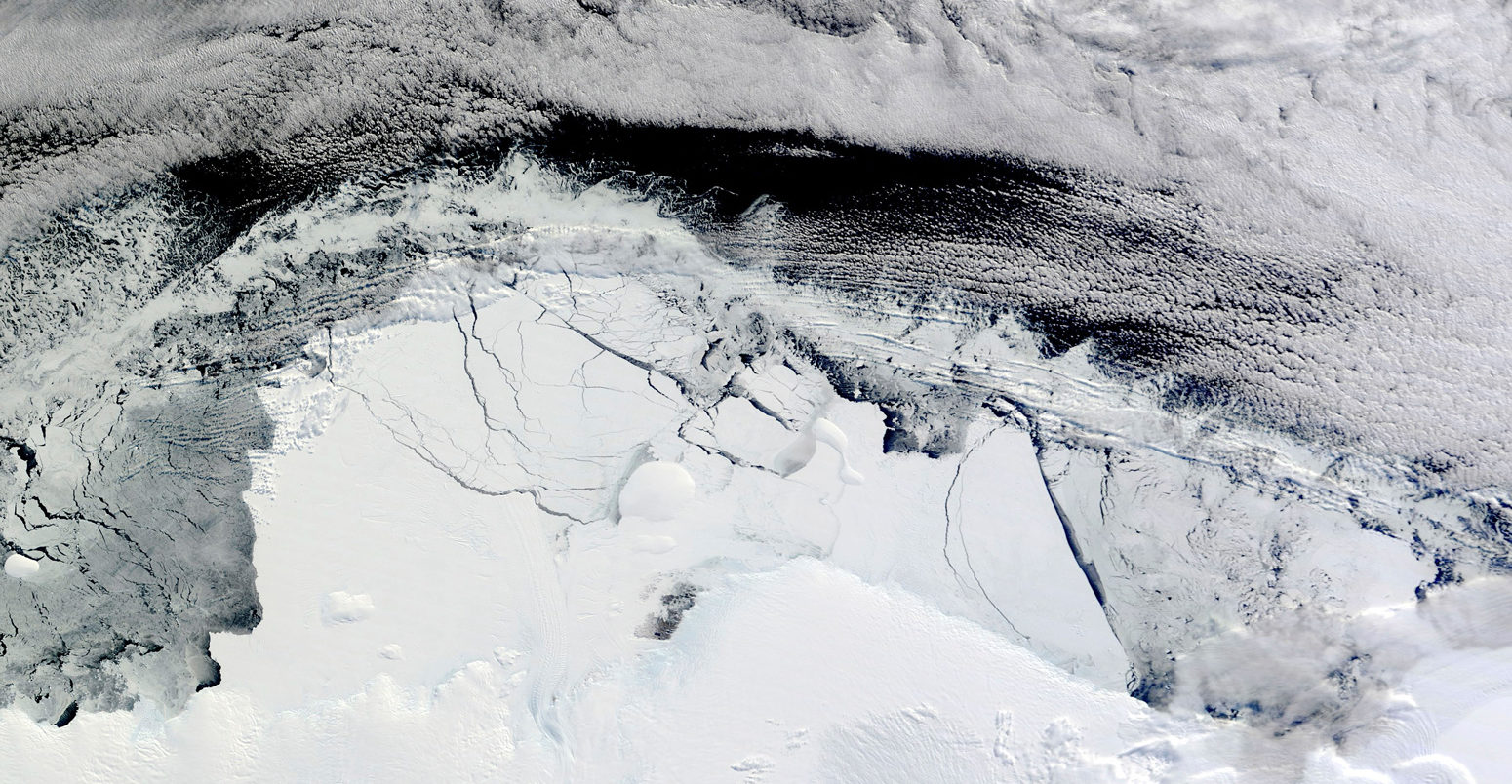
Guest post: The fate of Antarctic ice shelves at 1.5C, 2C and 4C of warming

Dr Ella Gilbert
04.08.21
Dr Ella Gilbert
08.04.2021 | 2:00pmAntarctica’s ice shelves – the floating tongues of ice formed where the ice sheet meets the ocean – are especially useful indicators of a warming climate. Sandwiched between the atmosphere and ocean, they can be melted from above or below.
Recent decades have seen the collapse of two Antarctic ice shelves, while a third is even melting during winter.
Ice shelves perform a crucial role, holding back glaciers that would otherwise flow freely into the ocean, pushing global sea levels ever higher.
Our new study, published in Geophysical Research Letters, my co-author and I focus on how one half of the sandwich – the atmosphere – influences the stability of Antarctic ice shelves.
We run model simulations of surface melt and snowfall on Antarctic ice shelves under three levels of future warming about pre-industrial levels: 1.5C, 2C and 4C.
The findings show that increasing quantities of meltwater on the surface of ice shelves can put them at risk of collapse through “hydrofracturing”. At 4C, for example, we find that four ice shelves – Larsen C, Wilkins, Pine Island and parts of the Shackleton ice shelf – are all vulnerable to collapse.
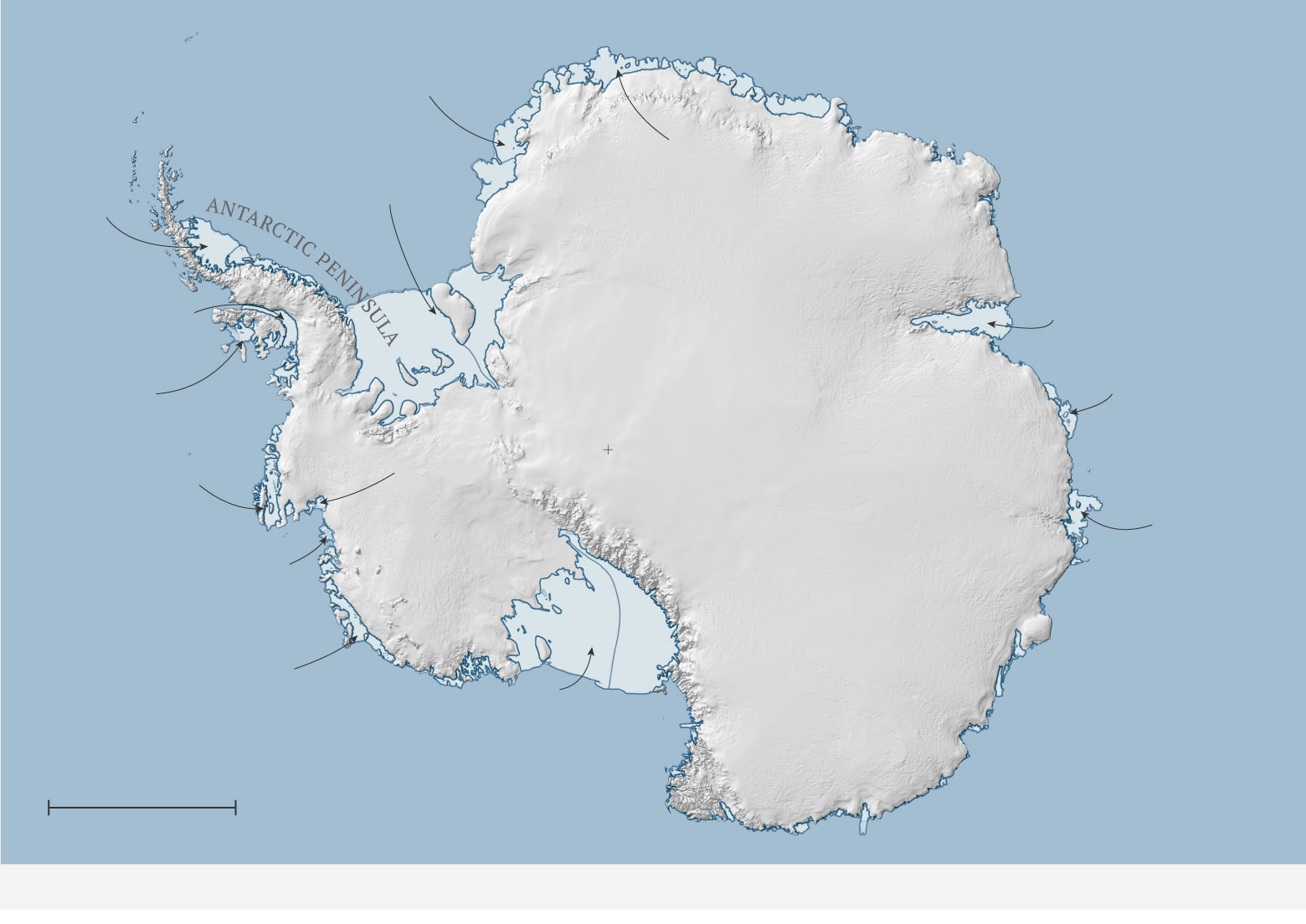
Riiser-Larsen
Fimbul
Filchner-Ronne
Larsen C
Amery
George VI
EAST ANTARCTICA
West
Wilkins
South pole
Pine Island
Abbot
Shackleton
WEST ANTARCTICA
Thwaites
Getz
Ross
1,000 km
Graphic: Carbon Brief. © Quantarctica / Norwegian Polar Institute
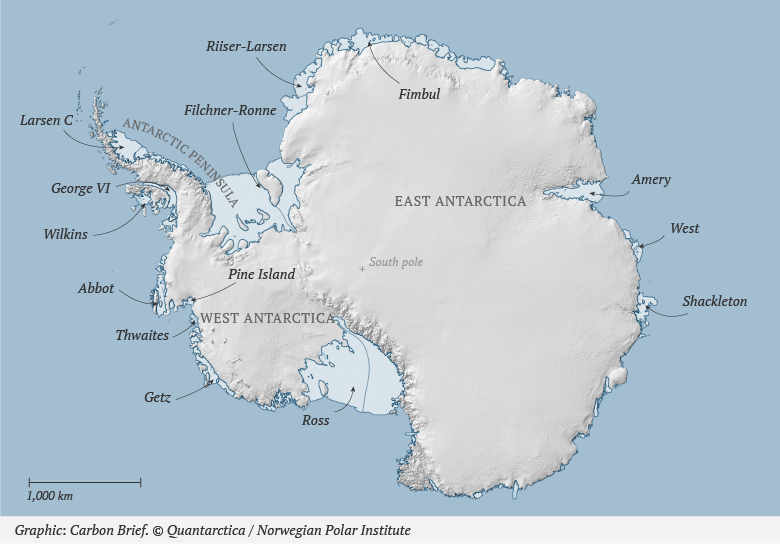
More warming, more melting, more runoff
While it is not surprising that more warming leads to more ice melt, it is perhaps less obvious that a warmer world can result in more snow. This is because warmer air can hold more moisture, which can then fall as snow.
At the surface, ice shelves grow when snow accumulates more quickly than it can be melted away. They shrink when ice melt in the summer outweighs the snowfall throughout the year.
The balance between these two competing factors – surface melt and snowfall – is called the “surface mass balance” (SMB) of an ice shelf.
But melting at an ice shelf’s surface has another effect. During the summer melt season, meltwater trickles into air gaps in the shelf, where it freezes again when temperatures drop.
After several years where melt exceeds snowfall, ice shelves can become saturated with refrozen meltwater. If that happens, any melt that forms the following summer has no gaps left to fill and simply collects on the surface or runs into deep fractures, such as crevasses and rifts.
Water is heavy, so when crevasses fill up they widen and deepen, and can reach the bottom of the shelf. This can trigger dramatic, large-scale disintegration called “hydrofracture”. This process caused the collapse of the Larsen A ice shelf in 1995 and Larsen B in 2002 on the Antarctic Peninsula.
As surface ice melt controls the amount of meltwater “runoff” on Antarctic ice shelves, it therefore plays a critical role in their vulnerability to hydrofracture.
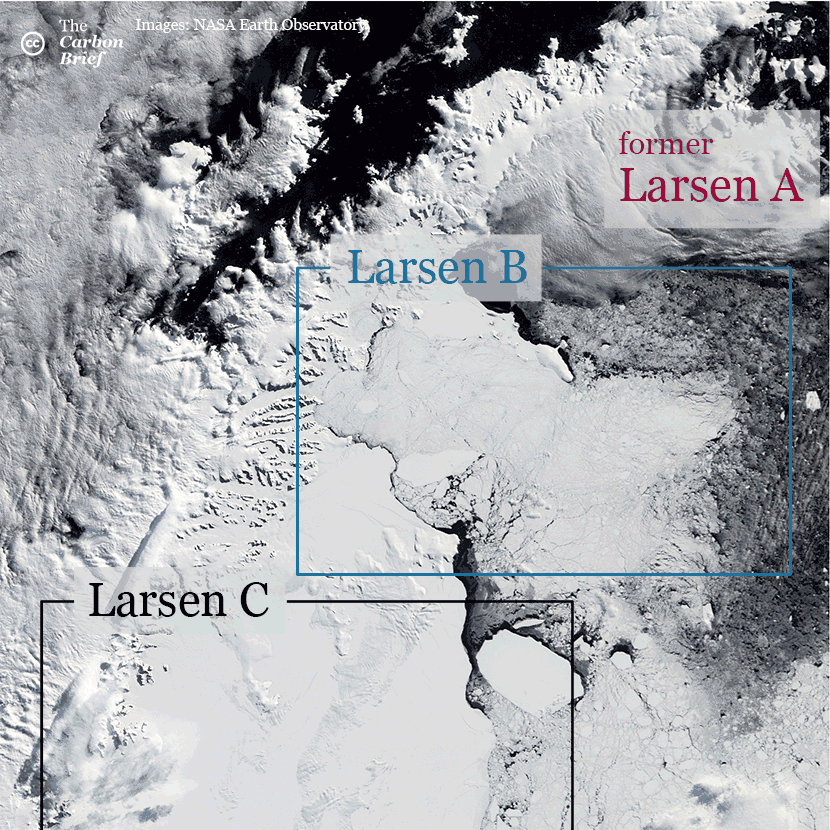
Ice shelves float on water, so when they thin or break up, the meltwater does not directly contribute to sea level rise. This is Archimedes’ principle, which also explains why ice cubes melting in a drink on a warm day do not change the overall level of liquid in the glass.
However, ice shelves still play an important role in holding back – of “buttressing” – the glaciers that feed them. Without the ice shelves in place, this land ice would flow more easily into the ocean – increasing sea levels. Thus, ice shelves have an indirect influence on sea level rise. It is for this reason that they are called the “gatekeepers” of ice flow off Antarctica.
Three warming levels
Using a regional climate model that is adapted to study the polar regions, we simulated the ice melt, runoff and SMB for Antarctic ice shelves under warming of 1.5C, 2C and 4C above pre-industrial levels. The regional model takes inputs from simulations of four different global models using the high emissions RCP8.5 scenario and its newer incarnation, SSP5-8.5.
We look at warming increments instead of end-of-century values to reduce the influence that differences between models have on the results. For example, some global models are slightly warmer or cooler than others during the historical period.
At more modest levels of warming – 1.5C and 2C – our results show that the increases in melt over ice shelves are mostly compensated by increased snowfall. As a result, runoff totals increase little above their historical values for 1980-2009.
The only place where melt increases considerably more than precipitation is the Antarctic Peninsula, where temperatures are already warmer and meltwater already collects on the surface during summer.
At 4C, though, runoff becomes much more widespread across Antarctica. This indicates that meltwater collects at the surface of more and more ice shelves because higher temperatures melt through snow quicker than it can accumulate.
You can see this in the chart below, which shows total melt (“ME”) and runoff (“RU”) increasing with warming, while the SMB remains fairly steady until warming reaches 4C. The icons indicate individual models, while the circles show the model average.
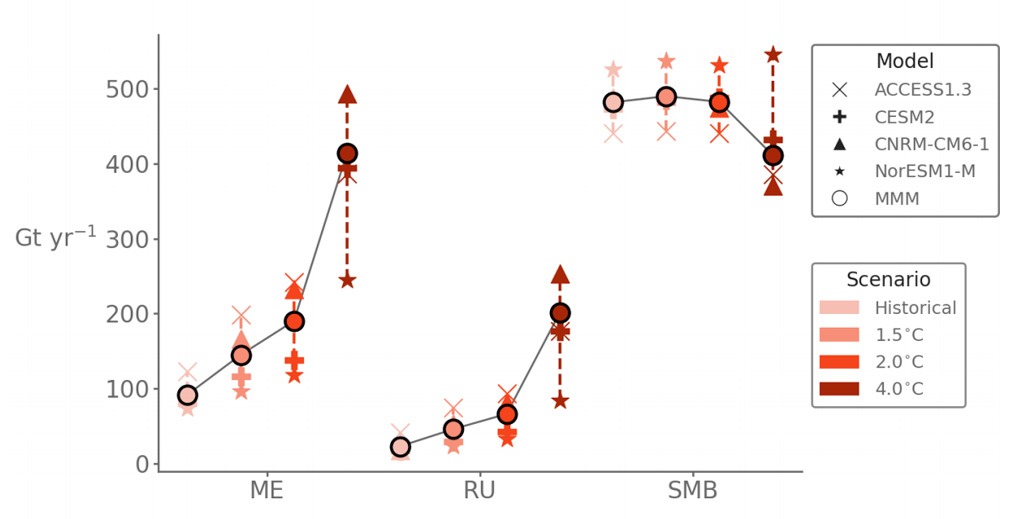
Interestingly, the picture of increasing melt and runoff over ice shelves is quite different from that over the grounded ice sheet – that is to say, the part of the ice sheet that covers the rocky continent.
Another new study shows that as the atmosphere warms, snowfall over grounded ice increases much more than melt does, meaning that the ice sheet gains mass in these places.
A larger proportion of ice shelf area becomes vulnerable
To understand the spatial scale of potential ice shelf vulnerability to hydrofracturing, we next simulated the overall proportion of ice shelves with runoff at different levels of warming.
The chart below shows the total percentage of ice shelf area where runoff is projected, over time, for Antarctica as whole (top left), and then the Antarctic Peninsula (top right), East Antarctica (bottom left) and West Antarctica (bottom right). The model average is shown in black, with individual model projections given as coloured lines and the range of values shaded in grey.
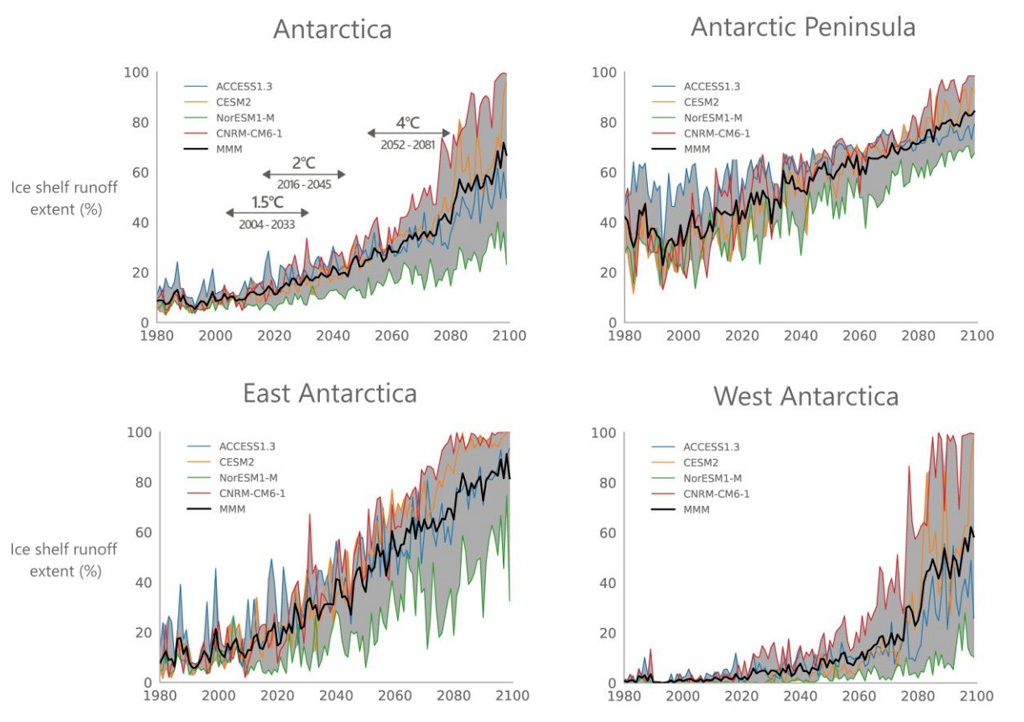
At increasing levels of warming, liquid water collects on the surface of a larger and larger proportion of ice shelf area. This suggests that some ice shelves are at increasing risk of destabilisation by meltwater-driven fracture.
At 1.5C and 2C of warming, runoff is projected over just 14% and 18% of Antarctic ice shelf area, respectively, which represents only a small increase above the historical average of 9% for 1980-2009.
The largest increases are seen in East Antarctica. Here, warming pushes summertime temperatures to the melting point more often, increasing the area where runoff occurs. For the Antarctic Peninsula, summertime melting is already quite widespread and so runoff extent there increases only slowly with warming.
At 4C above pre-industrial temperatures, our modelling suggests that up to 67% of ice shelf area on the Antarctic Peninsula, and 34% continent-wide, could be at increased risk of collapse. However, as is evident from the charts above, which shows a widening model range with time, there is less agreement between models at 4C.
How runoff is distributed between ice shelves matters, too. If runoff occurs over a small portion of many ice shelves it is less likely to drive hydrofracturing. However, if runoff is concentrated over a larger part of a smaller number of ice shelves, then those few will be more susceptible to destabilisation.
Our results suggest that, at 4C, significant runoff occurs over all Antarctic Peninsula ice shelves, two West Antarctic ice shelves – Abbot and Pine Island – and four East Antarctic ice shelves – Roi Baudoin, Amery, West and Shackleton.
Not all ice shelves are vulnerable to hydrofracture
It is important to note that not all areas where liquid collects on the surface are vulnerable to hydrofracture. A previous study showed that some shelves are resilient to surface-driven collapse because of their structure and geography.
For example, the George VI ice shelf on the Antarctic Peninsula is hemmed in on all sides by land, and several East Antarctic ice shelves are very stable because of the way they’re formed. On these ice shelves – including the Roi Baudoin, Amery and George VI – meltwater can collect at the surface every year without causing the shelf to fracture.
Our study, therefore, identifies ice shelves that could be vulnerable to collapse, if the right combination of factors – geography, structure, atmospheric warming – is present.
The map below shows the ice shelves that our study suggests could be at risk of hydrofracture-induced collapse at 4C (red shading) and those that are likely more resilient (orange).
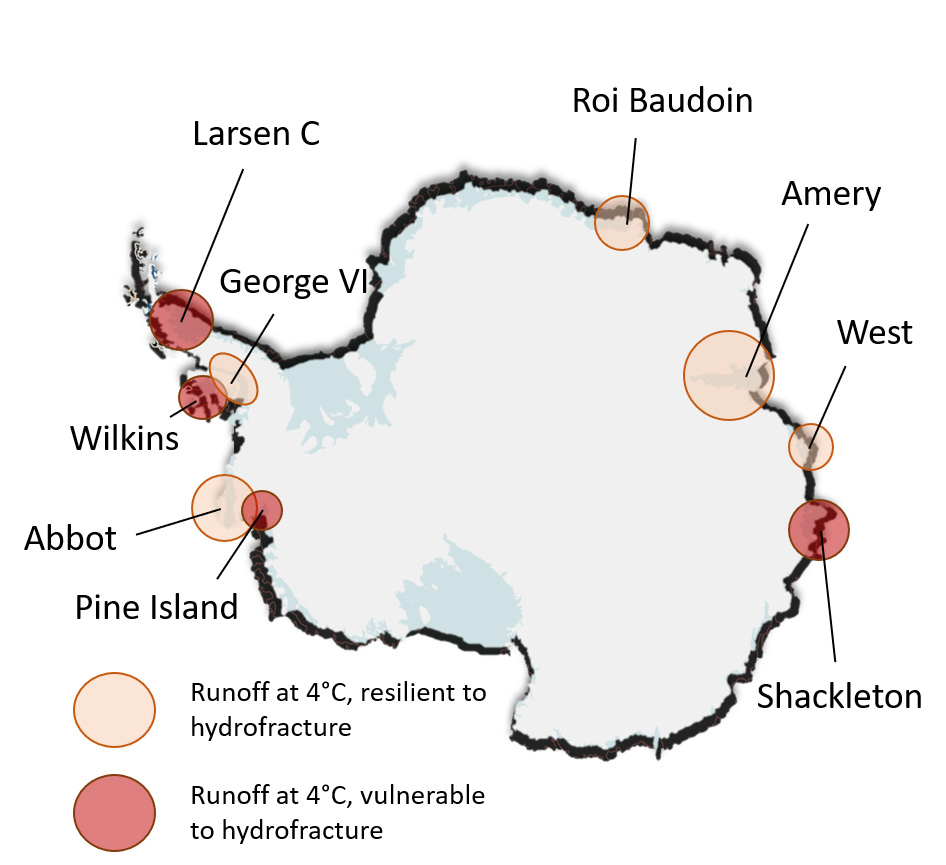
Those most at-risk of disintegration due to atmospheric warming and surface melting include the Larsen C and Wilkins ice shelves on the Antarctic Peninsula, Pine Island in West Antarctica and parts of the Shackleton ice shelf in East Antarctica.
Predicting the precise fate of Antarctic ice shelves is extremely challenging, but clearly, curbing atmospheric warming will reduce the chances of dramatic collapse events. Limiting warming to 2C will halve the ice shelf area susceptible to hydrofracturing compared to 4C.
Minimising the risk of ice shelf collapse is not just good for Antarctica. Keeping ice shelves intact means less sea level rise, which is good news for us all.
Gilbert, E. & Kittel, C. 2021: Surface melt and runoff on Antarctic ice shelves at 1.5C, 2C and 4C of future warming, Geophysical Research Letters, doi:10.1029/2020GL091733
-
Guest post: The fate of Antarctic ice shelves at 1.5C, 2C and 4C of warming

